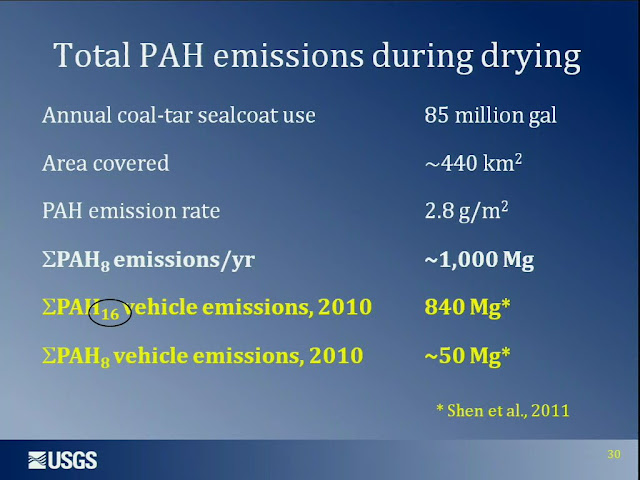 There is an abundance of research on the air quality impacts of polycyclic aromatic hydrocarbons (PAH’s). While much of the work has focused on industrial workers1, recent studies have included the effects of airborne PAH’s on the unborn including obesity2, lower IQ 3, and behavioral problems 4. Very few studies have been done specifically on coal tar pavement sealants and its effect on air quality. It isn’t surprising since the discovery of coal tar based sealcoat as a water quality or stream sediment problem pollutant has been in the last 10 years.
There is an abundance of research on the air quality impacts of polycyclic aromatic hydrocarbons (PAH’s). While much of the work has focused on industrial workers1, recent studies have included the effects of airborne PAH’s on the unborn including obesity2, lower IQ 3, and behavioral problems 4. Very few studies have been done specifically on coal tar pavement sealants and its effect on air quality. It isn’t surprising since the discovery of coal tar based sealcoat as a water quality or stream sediment problem pollutant has been in the last 10 years. This all changed with two recent publications5, 6 by the United States Geological Survey (USGS) of air sampling of coal tar sealed surfaces in Austin, Texas. The USGS sampled the air quality above parking lots where they were either aged coal tar sealant, new coal tar sealant or asphalt without any sealant at all. While air pollutants are often measured when they are in a gas phase, in a particle phase or combined for a total amount, the USGS’s research focused on the gaseous or non-particle PAHs. Since abrasion is a key component of pavement sealant wearing, the numbers calculated are on the lower end of the total.
| Mechanism for sealant mobility. |
Here’s a summary of their findings:
- Annual PAH emissions from coal tar sealants exceed those from US vehicular emissions. Engine exhaust is usually cited as a major contributor to urban PAH air pollution.
- There was a 50% loss of PAHs from the product in the first 45 days after application via airborne releases.
- The maximum concentration measured after the application of a coal tar sealant was 297,000 ng per cubic meter. The OSHA limit is 200,000 ng per cubic meter7.
- Concentrations of one PAH above sealed lots were 10–15 times higher than those measured for global industrial cities, but were not higher than 2 Chinese industrial cities.
- Mean concentration 4 feet above a coal tar sealed surface is 138 ng per cu. meter but the value found that affects the unborn is just 36 ng per cu. meter8.
| Summary of USGS PAH concentrations above coal tar sealed and unsealed surfaces. |
 |
| Annual PAH emissions from coal tar sealants exceed those from US vehicle emissions. |
The Role of PAH’s in Standard Air Quality Parameters
The common vernacular for air quality today is ozone and particulate matter (PM). What role, if any, do pavement sealants play in these air quality measurements?
PAH’s are a type of chemical which are referred to as SVOC’s or semi-volatile organic compounds. Volatile means it easily changes from a liquid to a gas, but an SVOC may partially exist as a solid and a gas. The volatile portion of PAH’s are readily attached to airborne particulates and contribute to the portion of problematic PM2.5 9
While I haven’t quite found a summary of the contribution of PAH’s to PM2.5, the following summary from an air quality study on PAH’s is worth quoting:
Many countries have proposed a non-mandatory concentration limit for PAHs, whereas the health risk studies conducted in relation to PAH exposure, urge that these pollutants should be given a high priority when considering air quality management and reduction of impacts.10
